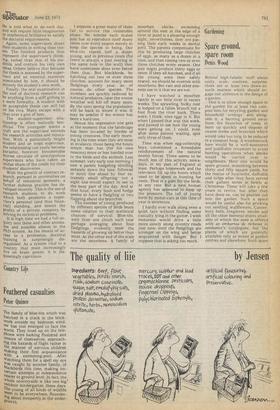'Country Life
Feathered casualties
Peter Quince The family of blue-tits which was hatched in a crack in the brickWork outside my bedroom window has just emerged to face the world. They lined up on the telePhone wire looking flustered and unsure of themselves, approaching the hazards of flight rather in the manner of nervous children Making their first acquaintance With a swimming-pool. After Watching them for a spell my eye ly,as caught by another family, of oiackbirds this time, making uncertain attempts at independence nearer to ground level. In fact, the Whole countryside is like one big outdoor kindergarten these days. The young of all kinds of wildlife eertt to be everywhere, floundering about inexpertly in the undergrowth. I suppose a great many of them fail to survive this vulnerable phase. No wonder each mated pair has to reproduce itself many times over every season merely to keep the species in being. Our blue-tits reared half a dozen young, and in previous years (for there is always a pair nesting in
the same hole in the wall) they have sometimes done even better than that. But blackbirds, by hatching out two or even three clutches, account for many more fledglings every year, as, of course, do other species. The numbers are quickly reduced by natural predators; later the winter weather will kill off many more. By the next spring the population will be back to where it was. It may be sm'aller if the winter has been a hard one.
Hence the impression one gets at the moment that the landscape has been invaded by hordes of young creatures. The early morning is the time when they are most in evidence, those being the hours which man has (for his own reasons) more or less handed over to the birds and the animals. Last summer, very early one morning I saw a parent hedgehog strolling sedately down the lane, followed in strict line ahead by four extremely small offspring: not a sight one would expect to see in the busy part of the day. And at that hour, every bush and hedge seems to have a fledgling or two flapping about the branches. The number of young produced by different species of birds bears some relation to their statistical chances of survival. Blue-tits, with their one clutch each year perhaps averaging about four fledglings, evidently meet the hazards of growing up better than most. At the other end of the scale are the moorhens. A family of
moorhen chicks swimming around the nest at the edge of a river or pond is a pleasing enough sight; nevertheless, they are passing their early weeks in mortal peril. The parents compensate for this by producing large clutches of eggs, as many as a dozen at a time, and then raising two or even three clutches every season. One pair might produce thirty eggs or more. If they all hatched, and if all the young were then safely reared, we should be overrun with moorhens. But rats and other enemies see to it that we are not.
I have watched a moorhen family in our little river in recent weeks. The sprawling, bulky nest is lodged on a fallen branch not a foot from the river bank. There were, I think, nine eggs in it. But when I passed that way this week, and paused to see how the young were getting on, I could, even after some patient waiting, spot only three of them.
Time was when egg-collecting boys constituted a formidable reinforcement of the natural enemy forces. There seems to be much less of this activity nowadays, in my part of England at • least. Perhaps homework and the television fill up the hours which used to be spent in hunting for nests. That is a gain for the birds, at any rate. But a new human agency has appeared to keep up the pressure. The toll of young birds by motor-cars at this time of year is enormous.
I hardly ever walk along even a quiet lane without finding some casualty lying in the gutter. I wish motorists would drive a little more slowly along country roads just now, until the fledglings are stronger on .the wing and better acquainted with danger. But I suppose that is asking too much.


































 Previous page
Previous page